
Edward Winter
Javier Asturiano Molina (Murcia, Spain) requests details regarding Paul Morphy as a problem composer.
On pages 17-18 of Paul Morphy The Pride and Sorrow of Chess David Lawson’s treatment of the famous Morphy two-mover covered the following points:

Mate in two
It is worth casting an eye over earlier attempts to sort out the facts about the two-mover. Alain C. White wrote on page 157 of his book The White Rooks (Stroud, 1910):
‘It would be curious to know the origin of this little trifle. I have not traced it back further than 1888, when H. Lehner the editor of the Lesehalle referred to it as the only problem composed by Morphy. Seeing the wonderfully subtle mates which Morphy was able to announce in his actual games, the production if genuine is also disappointing.’
Sergeant quoted most of that passage on page 347 of Morphy’s Games of Chess (London, 1916), and on page 110 of his complementary book Morphy Gleanings (London, 1932) he added:
‘On the authority of General John Tillson of Quincy, Illinois, this was a Morphy problem, composed by Paul before he was ten (!), and was shown to him by Ernest Morphy before his nephew made his great reputation. The problem was first published, apparently, by G.C. Reichhelm in the Philadelphia Times in 1887, which is earlier by a year than A.C. White’s first trace of it. It was republished in the Philadelphia Inquirer as late as 18 February 1920 (with the pieces transposed to the king’s side), and was prefaced by a reference to General Tillson’s statement.’
On page 11 Sergeant specified the chronology: after Reichhelm gave the problem in the Philadelphia Times in 1887 Tillson wrote to him about Morphy’s young age at the time of composing it. It would seem, though, that Sergeant’s source was merely the (1920) republication of the story, and that he did not have the Philadelphia Times of 1887. Can any reader provide that earlier text?
(5141)
Michael McDowell (Westcliff-on-sea, England) has found that the New York Clipper can be viewed on-line [updated link]. He comments that the chess column was usually published on page 6 of the Saturday edition and that there were also occasional chess features elsewhere.
Morphy’s only authenticated problem, composed some seven years previously, is on page 78 of the 28 June 1856 edition. (For further information, see pages 18-19 of David Lawson’s biography of Morphy.)
(8473)
We revert now to how the two-mover was discussed in Gustavus Charles Reichhelm’s chess column in the Philadelphia Times:
30 January 1887, page 12:
‘Morphy’s only problem
It is not generally known that Paul Morphy once set up a problem of his own and the position therefore has a peculiar interest.’
A diagram of the two-mover followed, with the kings on f8 and h8.
13 February 1887, page 7:
‘The position kindly sent by a correspondent as a “Morphy problem” is a celebrated two-er by F. Herlin.’
20 February 1887, page 10:
‘General John Tillson, of Quincy, Ill., writes:
“To the mention which you made of problem 712 it might have been added that the problem was composed by Paul Morphy before he was ten years of age. This is the fact. His uncle, Ernest Morphy, who was, as you must remember, in the first rank of American players, showed me this pretty little problem before Paul had made his swoop at the New York Tournament, to the head of American chess, and as it proved to the precedent place among the chessplayers of the world. Mr Ernest Morphy was full of pleasant little anecdotes about ‘Leetle Paul’, as he used to style him, and predicted his certain success against the best players in the world, and showed this problem as the only one that he knew Paul to have made, but as indicative of his precocious intuitive capacity for chess. Ernest Morphy’s description of Paul’s contests with Löwenthal, when the little fellow – for he was small as boy and small when a man – stood up to the table instead of being seated, etc., was very interesting, and many other remembrances I have from the elder Morphy (who lived a long time and died here) about his gifted nephew.
I had never seen this problem (712) in print before, but have had it in my possession for 30 years.”
General Tillson adds that Paul composed the problem at nine years of age, and we hope we can induce the General to give us many more of his pleasant and entertaining anecdotes about Paul Morphy.’
2 March 1902, page 8:
The two-mover was given again (kings on c8 and a8), with no particular facts about the circumstances of the composition.
General Tillson’s reference to Ernest Morphy having died in Quincy, IL is confirmed by newspaper reports. For example:
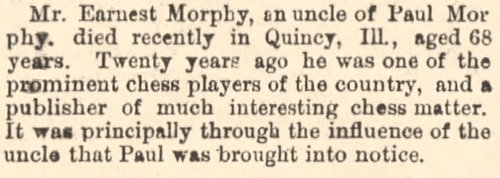
Brooklyn Review, 3 May 1874, page 5
In Reichhelm’s columns, no other references to General John Tillson or to ‘F. Herlin’ have so far been traced. The latter reference, in the 13 February 1887 column, has yet to be explained.
C.N. 8473 mentioned that this was the first known appearance of the composition, on page 78 of the New York Clipper, 28 June 1856:
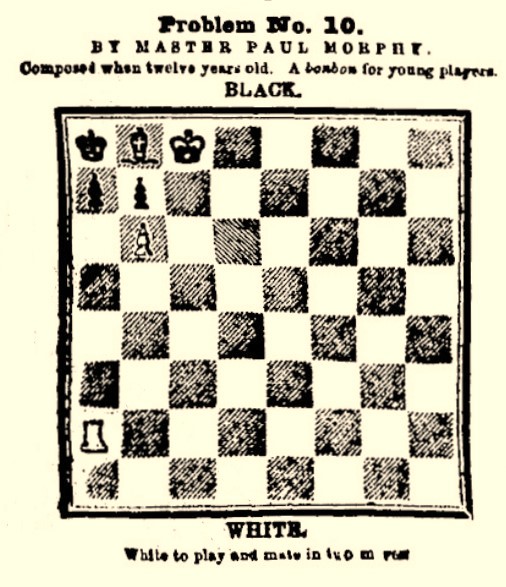
As noted by David Lawson on page 27 of his 1976 monograph on Morphy, the problem was sent to the New York Clipper with a letter from Ernest Morphy dated 10 June 1856 which referred to ‘a two-move enigma composed by Paul, as far back as 1849’. From page 70 of the 21 June 1856 edition:
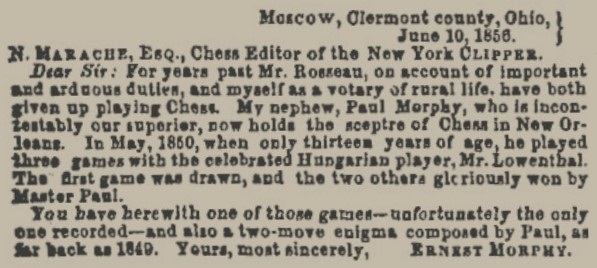
(12203)
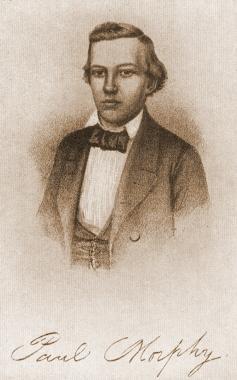
On page 327 of his book Lawson discussed a problem which ‘has often been falsely ascribed to Paul Morphy’. He reported that it was, in fact, by E.B. Cook, and ‘was first published under the initials “E.B.C.” by C.H. Stanley on 23 October 1852 in the New York Albion. Dr H. Keidanz published it as number 15 in The Chess Compositions of E.B. Cook.’
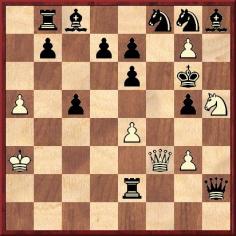
Mate in eight
Sergeant mentioned on page 347 of his book that the composer was Cook, not Morphy:
‘Another [problem] which was attributed to him in the Nuova Rivista degli Scacchi, July-August 1884, was afterwards traced to the late Eugene B. Cook, of Hoboken, being the well-known “Circus” Fantasy.’
In a later edition of the book (1919) Sergeant revised his comment as follows:
‘Another [problem], in eight moves, published as Morphy’s in the Chess Player’s Magazine, August 1864, is said to have been really composed by the late Eugene B. Cook.’
We add that the eight-mover was often seen ascribed to Morphy after his death, examples being page 66 of the Columbia Chess Chronicle, 1 October 1889 and the front page of the first number of the Chess Review, September 1892, as well as page 97 of the February 1893 issue. However, after it was given on page 83 of the April 1922 American Chess Bulletin Alain C. White reacted with a letter to the problem editor of the Bulletin, H.W. Barry. It was published on page 112 of the May-June 1922 issue:
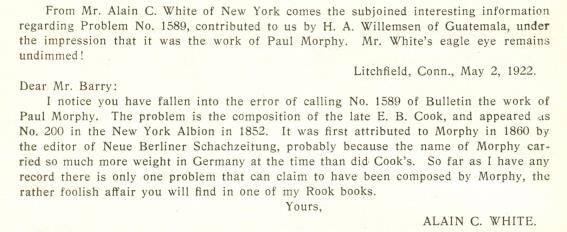
Can anything further be discovered as to how Morphy’s name became attached to Cook’s composition?
(5141)
To the Archives
for other feature articles.
Copyright Edward Winter. All rights reserved.